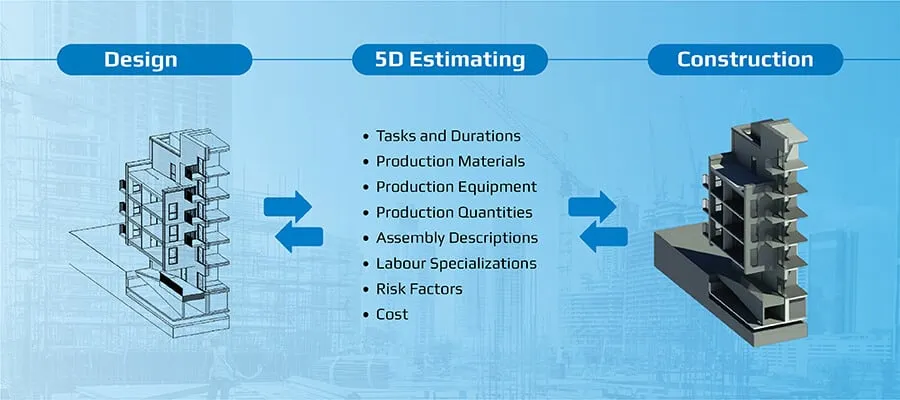The fusion of BIM and cost estimation, also known as 5D BIM Cost Estimation, is revolutionizing how professionals manage, assess, and optimize project budgets. This article delves into the world of 5D BIM Cost Estimation, its benefits, and its profound impact on Singapore’s construction landscape.
Picture a construction project brought to life through a digital replica – that’s the essence of a 5D BIM model. This model extends the capabilities of a 4D BIM model by introducing a critical dimension: cost. Beyond the mere arrangement of construction phases, a 5D BIM model factors in the cost of labour and materials required at each stage. Through the magic of automation, this model facilitates swift estimations for procurement, installation, operation, maintenance, and even renewal costs. These cost estimation documents become invaluable for tender bids and empowering clients to evaluate and manage their budgets effectively.

The true power of 5D BIM Cost Estimation becomes evident when considering the advantages it brings:
- Efficient Quantity Determination:The BIM model is a treasure trove of precise quantities for various building components. By marrying these quantities with current market rates, estimating the overall project cost becomes a streamlined process, eliminating the need for laborious manual calculations.
- Real-time Cost Impact Analysis:A standout feature of 5D BIM Cost Estimation is its ability to instantaneously calculate the cost implications of design changes. Every alteration resonates through the cost estimation, offering unparalleled accuracy in understanding the financial consequences of design decisions.
- Dynamic Design Exploration:Clients and stakeholders gain the ability to explore different design avenues. The software’s automated quantity generation and cost impact simulation empower insightful budget exploration for diverse design scenarios.
The Role of Quantity Take-offs in 5D BIM
Central to the 5D BIM Cost Estimation process is the concept of “quantity take-offs.” These detailed measurements of labour and material requirements are crucial for accurate cost estimates. Traditional methods involved manual assessments carried out by a Quantity Surveyor. However, the integration of BIM technology revolutionizes this process, enabling the extraction of data directly from the model. This not only expedites the generation of cost estimation documents for tender bids but also ensures precision in the quantities considered.

Advantages of Our 5D Quantity Take-Off Services
Our commitment to harnessing the potential of 5D BIM for cost estimation and quantity take-offs stands as a testament to modern construction excellence. Our services offer:
Accuracy in Assessment: Leveraging 5D BIM, we provide meticulous quantity assessments for precise material and resource estimations.
Comprehensive Cost Estimation: Our approach considers quantities, labor, and materials, paving the way for informed and accurate budgeting.
Seamless Schedule Integration: Integration of time and cost data within 3D BIM models facilitates visual project scheduling and analysis.
Optimization without Compromise: Designs are scrutinized for cost optimization while upholding quality and performance standards.
Transparent Payment Validation: Visual representations ensure transparent and precise payment processes, enhancing trust and collaboration.
Change Management Made Effortless: With 5D BIM data, we adeptly manage design changes while maintaining impeccable documentation.
Empowering Construction Excellence Through 5D BIM
The benefits of 5D BIM Cost Estimation extend beyond mere calculations:
Enhanced Collaboration and Communication: BIM technology fosters seamless collaboration among stakeholders, minimizing errors and enriching decision-making.
Clash Detection and Conflict Resolution: Early clash detection prevents rework and delays, a testament to the efficiency that BIM brings to the table.
Visualization for Informed Decisions: BIM’s 3D modelling prowess empowers design analysis, leading to well-informed decisions that optimize functionality.
Financial and Temporal Savings: With accurate quantity take-offs, cost estimation, and clash detection, BIM paves the way for cost control and minimized rework, translating to significant time and financial savings.
Sustainability and Efficiency: BIM allows for the evaluation of environmental impact, guiding decisions toward sustainable materials and energy-efficient designs.
In Singapore’s thriving construction arena, the integration of 5D BIM Cost Estimation has emerged as a game-changer, redefining how professionals envision, plan, and execute projects. As the industry marches toward a future of smarter, more efficient construction practices, 5D BIM stands tall as a beacon of innovation, efficiency, and excellence.
Author
-

An Emerging International Business Developer in the AEC Industry. Shankar is a Mechanical Engineer from India with a specialization in Mobility Engineering from the esteemed Politecnico di Milano University, Milan, Italy. Shankar is dedicated on exploring business opportunities in the Built Environment / BIM. He focuses on International Business Development Operations globally. He supports Team Conserve by Introducing New Client, Project Collaborations, Brand Awareness, New technology tool integrations and New Portfolio Creations.


